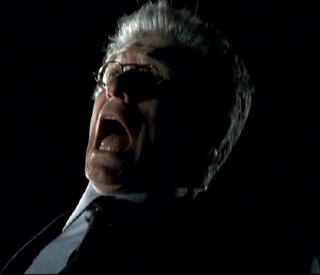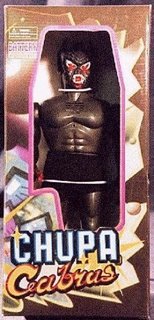
Somehow – presumably because I was doing something I thought more important, like alphabetically arranging the forks in my utensil drawer or creating plans for a time machine fueled solely by my contempt for the revival of the skirt-over-leggings look – I managed not to see Jason X, the tenth installment in the interminable Friday the 13th franchise, in either the theaters or on DVD.
To my great puzzlement, that problem was rectified last weekend.
Jason X starts in bowels of the Crystal Lake Research Center, an institution that, while high-tech enough to contain an elaborate cryogenic facility, looks pretty much like an abandoned parking garage. Here, scientists have been holding the infamous and unkillable Jason Voorhees using state of the art incarceration tech – by which I mean he's held still by a handful of what appear to be bicycle chains. The head of this fine institution, one Dr. Hottie McFinal-Girl, intends to freeze Jason until such time as a proper disposal system can be developed for him. Unfortunately, her brilliant scheme is disrupted by Dr. Stupid (played by, of all people, famed art-horror director David Cronenberg, shown above, who, I assume, lost some drunken bet and was obliged to appear in this flick) and his crack team of highly trained soldier-victims. They want to take Jason to another location and study his remarkable regenerative properties. Dr. McFinal-Girl objects. Apparently Dr. Stupid's lab would be less secure, though that scarcely seems possible. What, they don't have bike chains at the Saratoga site? Jason, of course, busts free seconds after Dr. Stupid and company arrive. The soldiers, with all their guns and training, prove no match for Jason, now armed with one of his bike chains. Jason then chases Hottie to the cryogenic lab where he and she, through a series of misadventures, get frozen and, Buck Rogers-like, are thrown four centuries into the future.
Our lead icicles are found by a scavenger crew from Earth 2, where humans fled after years of environmental decay made Earth: Original Formula uninhabitable. The scavengers bring both of the frozen folks back to their ship: the Grendel. (We later encounter a ship called the Tiamat – in the future all ships are named by D&D players and it is not unusual to serve on ships with names like the S.S. Encumbrance Check.) They carefully thaw out Dr. Hottie. To her credit, she takes the news that she has just woken up four hundred years in the future and that everybody she knows, and even the plant she called home, are now dead with remarkable aplomb.
Jason, who thaws out on his own (because he's Jason, dammit, and it'll take a bit more than 400 years of exposure to absolute zero to keep him down), also takes the transition well. After several milliseconds of adjustment to his new, high-tech surroundings, he decides that this new context does not radically alter his core competencies, and he begins killing like his old self. After all, teens making whoopie is teens making whoopie no matter what century you're in. And where folks is making whoopie, Jason's got killing to attend to. Mostly he relies on a future version of his trusty ol' machete, but he finds time to expand his repertoire to keep pace with the rapid changes around him: freezing a woman's face with liquid nitrogen and then smashing it off (in the future, people keep sinks of room-temp stable liquid nitrogen in their labs), impaling folks by dropping them on large drill bits, impaling folks on what appears to be some sort of space anchor.As an aside, in many ways, Jason's machete is a symbol for the downward spiral of the entire franchise. The young, pre-zombie Jason was a tireless innovator of the fatal applications of garden impliments and construction tools. This was a trait he got from his mother, who, though blinded by murderous rage, found novel ways of dispatching teens. Though, even she seemed like some middle-class housewife once Jason hit his stride and was approaching McGuyverish levels of tool use. However, as time went on, Jason came more and more to rely on the old machete. In many ways, it became as much a part of his persona as the hockey mask. But there was a difference. The hockey mask, which didn't even arrive on the scene until the third flick, was an inspired bit of branding (if a bit of a rip from the less prolific Halloween franchise). The machete, however, is a concession to laziness. Why put in the extra effort when you can just chop away with the good ol' machete? Yep, the ol' machete never lets you down. It is as if, twenty years of unlife later, Jason's lost the fire in the belly. He can still kill as well as you please, but he doesn't want it any more.
As the bodies and contrivances pile up, eventually Jason gets nano-tech'ed up and appears as Uber-Jason – at least, that's how he's credited. This is a bit of a let down as the Uber-Jason is basically the same old unstoppable killing machine who likes to bash people around and whack folks with his machete. That's right. No laser eyes. No death ray from the palm. No missile launcher built into his chest. He gets his eye-color changed and they chrome some parts of him, but otherwise the transformation is shrug-inducing. He comes off like Iron Man's retarded baby brother.
Though somebody deserves some credit for trying to aggressively rejuvenate an increasingly stale series, the combination of genre elements in Jason X adds up to something less than the sum of its parts. The sci-fi trappings, which are only a shade better than a made-for-TV original, work against the horror genre – Jason seems incongruous and silly among the flashing lights and hissing, Trek-style doors. The efforts at self-aware humor – while providing one conceptually brilliant scene, the idea of trapping Jason in a holodeck-style simulation of Crystal Lake circa 1980 – kill the already weakened fright-factor. The gore seems more goofy than visceral; the change in context works against the recognition of frailty that makes slasher flicks work. We can imagine getting whacked in the head by an axe but when you've got to puzzle out exactly what it is somebody was killed with, your fear devolves into slight confusion.
Really, the only thing Jason X has going for it is the also the only convincing reason to rent it: the concept of putting Jason in space is just so bizarre that it has its own attraction beyond the actual elements of the film. There's a certain odd pleasure in watching such a strange and obviously bad concept play out. As such, Jason X is a lame movie that still has an undeniable charm of sorts. Using the justly controversial, but wholly appropriate Order of Battle in the Indochina Expedition of 1940, I'm giving this movie an overall score of the 9th Infantry Brigade, with a bonus 3rd Regiment Tirailleurs Tonkinois in recognition that the film is still kinda fun in a goofy sort of way.




















